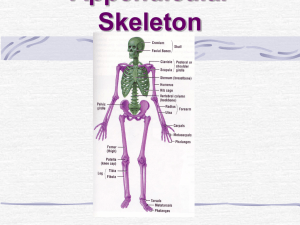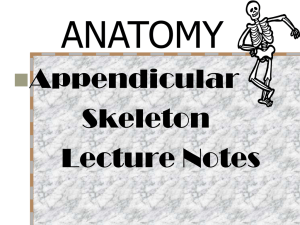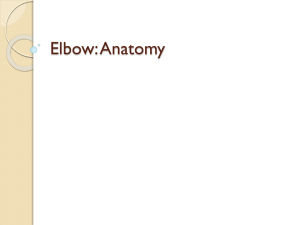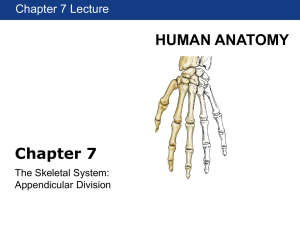Chapter 8: The Appendicular Skeleton
advertisement
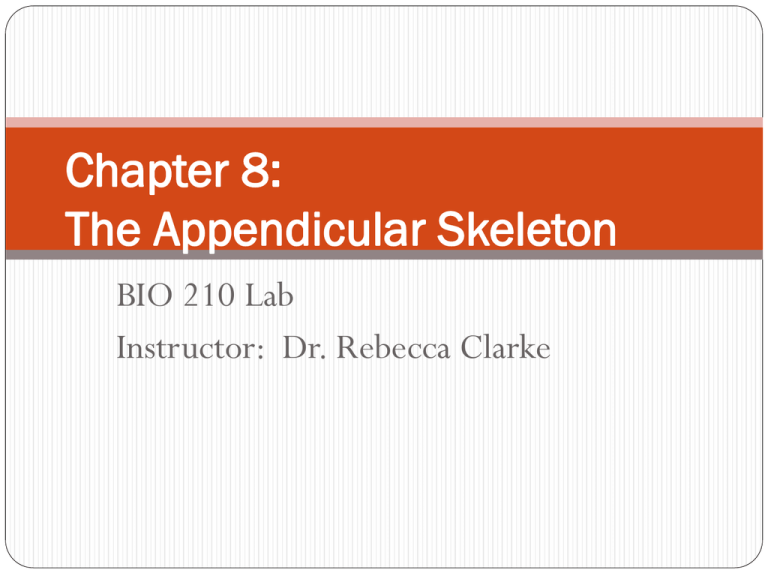
Chapter 8: The Appendicular Skeleton BIO 210 Lab Instructor: Dr. Rebecca Clarke Appendicular Skeleton Allows us to move and manipulate objects Includes all bones besides axial skeleton: the limbs the supportive girdles Pectoral (shoulder) Pelvic Appendicular Skeleton Figure 8–1 Pectoral Girdle Also called the shoulder girdle Positions shoulder joints Connects the arms to the body Provides base for muscle attachment Helps move upper limbs Pectoral Girdle Figure 8–2a Pectoral Girdle Consists of: 2 clavicles 2 scapulae Connects with axial skeleton only at the manubrium (clavicle articulations) Clavicle Also called collarbone Long, S-shaped bone Originates at manubrium (sternal end) Articulates with scapula (acromial end) Relatively fragile so fractures common Clavicle Sternal End: Square, flat surface Articulates with manubrium; only ones between axial skeleton and pectoral girdle Acromial End: Flatter, broader end Articulates with acromion of scapula Figure 8–2b, c Scapula Also called shoulder blade Broad, flat triangle Articulates with arm and collarbone Skeletal muscles support/position Extreme mobility Not much strength Scapula: Posterior Surface Body Broad, flat, triangular area Has 3 borders/ margins Superior Medial Lateral Figure 8–3c Scapula: Posterior Surface Spine Large ridge across posterior surface Shoulder blade Supraspinous fossa Depression superior to spine Infraspinous fossa Depression inferior to spine Figure 8–3c Scapula: Posterior Surface Acromion Large, posterior extension at lateral end of spine Articulates with clavicle (acromial end) Figure 8–3c Scapula: Lateral View Glenoid fossa (cavity) Cup-shaped, lateral depression Articulates with humerus Forms shoulder joint Figure 8–3c Scapula: Lateral View Coracoid process Smaller, anterior projection superior to glenoid cavity Near clavicle vs coronoid process on mandible near nose) Figure 8–3c Scapula: Anterior Surface Subscapular fossa Depression on smooth, anterior side of body Figure 8–3a Bones of the Upper Limbs Brachium (arm) Antebrachium (forearm) Ulna Radius Carpals (wrist) Metacarpals (hand) Phalanges (fingers) Humerus Only bone in brachium (arm) Extends from scapula to elbow Articulates with pectoral girdle on proximal end (head) – with glenoid fossa of scapula on distal end – with radius and ulna (bones of antebrachium) Humerus Head Large, ball-shaped structure on proximal end Greater tubercle Larger, rounded projection on lateral/posterior surface of epiphysis Lesser tubercle Smaller projection on medial/anterior surface Intertubercular groove Separates tubercles Figure 8–4 Humerus Anatomical neck Narrow groove between base of head and tubercles Margin of joint capsule Surgical neck At metaphysis Where fractures often occur Deltoid tuberosity Rough ridge on-anterior surface of shaft Where deltoid muscle attaches Figure 8–4 Humerus Condyle = rounded projection for muscle attachment Distal epiphysis where humerus articulates with radius and ulna “Knuckles” on anterior surface of humerus Figure 8–4 Humerus Lateral epicondyle Medial epicondyle More prominent than lateral one Trochlea (“pulley” or “spool”) In center of condyle (middle “knuckle) Where trochlear notch of ulna rotates during forearm flexion Capitulum Forms a “cap” over the radius Figure 8–4 Humerus Coronoid fossa On anterior surface Articulates with coronoid process of ulna Olecranon fossa On posterior surface Articulates with olecranon of ulna Figure 8–4 Antebrachium (Forearm) Consists of 2 long bones: Ulna (medial) Radius (lateral) “Rotates” Site of radial pulse Figure 8–5 Ulna Olecranon (process) Large, curved projection (like cobra head) on proximal end “U” for ulna Articulates in olecranon fossa of humerus Superior lip of trochlear notch Point of elbow Figure 8–5 Ulna Trochlear notch Anterior curved surface of proximal epiphysis Articulates with trochlea of humerus Coronoid process Inferior lip of trochlear notch Articulates in coronoid fossa of humerus Figure 8–5 Ulna Head Much smaller, distal epiphysis (near wrist) Articulates with radium and carpal (wrist) bones Styloid process Medial pointed extension at distal epiphysis On posterior, lateral surface of head Figure 8–5 Ulna: Articulations with the Humerus Forearm extended: Olecranon enters olecranon fossa Forearm flexed: Coronoid process enters coronoid fossa Radius Head Disc-shaped proximal epiphysis Articulates with humerus Neck Narrow region between head and tuberosity Radial tuberosity Structure at proximal end of diaphysis below neck Marks attachment site of biceps brachii muscle Figure 8–5 Radius Shaft Curves and broadens Distal portion much larger than distal portion of ulna Styloid process Lateral pointed extension at distal epiphysis Stabilizes wrist joint Figure 8–5 Carpal Bones Allow wrist to bend and twist 8 bones “Sam likes to push the toy car hard.” Carpal Bones Scaphoid Trapezium Lunate Trapezoid Triquetrum Capitate Pisiform Hamate Wrist and Hand Bones Figure 8–6 Metacarpal Bones 5 long bones of the hand Numbered I–V from lateral (thumb) to medial Articulate with proximal phalanges Phalanges (Phalanx=singular) Finger bones I (lateral) Pollex (thumb): 2 phalanges (proximal, distal) II -V 3 phalanges (proximal, medial or middle, distal) Pelvic Girdle Functions Weight-bearing Locomotion Bones more massive than those of pectoral girdle Strong to bear body weight Pelvic Girdle Made up of 2 hip bones (coxal bones or pelvic bones) Each hip bone is made up of 3 fused bones: Ilium (articulates with sacrum) Ischium Pubis Pelvic Girdle Figure 8–7 Pelvic Girdle: Ilium Largest hip bone Superior part of coxae Fused to ischium (posteriorly) and pubis (anteriorly) Articulates with sacrum – attaches pelvic girdle to axial skeleton Figure 8–7 Pelvic Girdle: Ilium Iliac crest Superior border Anterior superior iliac spine (ASIS) Anterior inferior iliac spine (AIIS) Posterior superior iliac spine (PSIS) Posterior inferior iliac spine (PIIS) Figure 8–7 Pelvic Girdle: Ilium Iliac fossa Depression on anterior aspect Sacroiliac joint Between posterior superior and inferior spines; where ilium and sacrum articulate Greater sciatic notch Inferior to PIIS Passageway for large sciatic nerve Figure 8–7 Pelvic Girdle: Ischium Posterior-inferior part of coxae Ischial spine Inferior to greater sciatic notch At posterior-superior end Lesser sciatic notch Inferior to ischial spine Ischial tuberosity Thickened posterior-inferior part Bears body weight when seated (“sit bone”) Figure 8–7 Pelvic Girdle: Pubis Anterior-inferior part of coxae Pubic symphysis Joint where anterior medial surfaces of pubic bones are interconnect by fibrocartilage pad Limits movement between pubic bones of left and right hipbones Figure 8–7 Pelvic Girdle: Acetabulum Also called the hip socket Large, concave socket on lateral surface of os coxae Meeting point of ilium, ischium, and pubis Articulates with head of femur Figure 8–7 Pelvic Girdle: Obturator Foramen Large space encircled by pubis and ischium Closed by sheet of collagen fibers Provides base for hip muscles Figure 8–7 Pelvis Consists of: 2 hip bones Sacrum Coccyx (of axial skeleton) Stabilized by ligaments of pelvic girdle, sacrum, and lumbar vertebrae Pelvis Figure 8–8 Pelvic Openings Pelvic inlet – (anterior) space enclosed by pelvic brim Pelvic outlet – opening bounded by coccyx and ischial tuberosities Figure 8–9 Pubic Angle Inferior angle between pubic bones Figure 8–10 Bones of the Lower Limbs Femur (thigh) Patella (kneecap) Tibia and fibula (leg) Tarsals (ankle) Metatarsals (foot) Phalanges (toes) Femur Longest, heaviest bone Transfers body weight to ground Articulates with: coxae at acetabulum tibia at knee joint Figure 8–11 Femur Head Large, round proximal end Articulates at acetabulum Neck Narrow connector between head and shaft Joins shaft at angle Figure 8–11 Femur Greater trochanter Large process at superior end of shaft Lesser trochanter Smaller process inferior to neck on medial /posterior side Figure 8–11 Femur Lateral condyle Large, rounded, lateral projection at distal epiphysis Articulates with lateral condyle of tibia Medial condyle Large, rounded, medial projection at distal epiphysis Articulates with medial condyle of tibia Figure 8–11 Femur Intercondylar fossa Depression between condyles on posterior side Figure 8–11 Femur Patellar surface Flattened area between condyles on anterior side Figure 8–11 Patella Large sesamoid bone Forms within tendon of quadriceps femoris (extends/straightens the knee) Figure 8–12 Tibia Larger, medial bone; supports body weight Also called the shinbone Figure 8–13 Tibia Lateral condyle Lateral projection at proximal epiphysis Articulates with lateral condyle of femur Medial condyle Medial projection at proximal epiphysis Articulates with medial condyle of femur Figure 8–13 Tibia Tibial tuberosity Roughened area on anterior surface Inferior to condyles Attachment for patellar ligament Figure 8–13 Tibia Anterior margin Ridge that begins at tibial tuberosity and extends distally along anterior surface (“shin bone”) Medial malleolus (“little mallet”) Projection on medial side at distal epiphysis Figure 8–13 Fibula Slender, lateral bone of lower leg Figure 8–13 Fibula Head Articulates with proximal tibia Lateral malleolus Projection on lateral side at distal epiphysis Articulates with distal tibia Provides lateral stability to ankle Figure 8–13 Tarsal Bones Allow ankle to bend and twist 7 bones Ankle and Foot Bones Figure 8–14a Tarsal Bones Talus Cuneiforms (3) Calcaneous Navicular Cuboid Note: movement more restricted than wrist/hand Metatarsal Bones 5 long bones of the foot Numbered I–V from medial (big toe) to lateral Articulate with proximal phalanges Phalanges Toe bones I (lateral) Hallus (big toe): 2 phalanges (proximal, distal) II -V 3 phalanges (proximal, medial or middle, distal)
